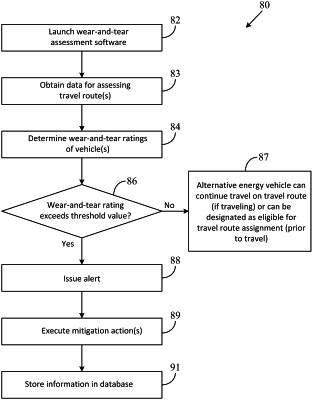| CPC B60W 10/08 (2013.01) [B60L 58/12 (2019.02); B60W 10/26 (2013.01); B60W 40/06 (2013.01); B60W 40/105 (2013.01); G08G 1/202 (2013.01); B60L 2240/423 (2013.01); B60W 2510/083 (2013.01); B60W 2510/242 (2013.01)] | 6 Claims |

|
1. A method comprising:
simultaneously assigning, using one or more processors, a plurality of vehicles to a plurality of travel routes for a first number of trips over a first period of time;
capturing data in real-time by vehicle computers of the plurality of vehicles while the plurality of vehicles are traversing the plurality of travel routes;
determining, using the one or more processors, first vehicle speed ranges for first segments of the plurality of travel routes and second vehicle speed ranges for second segments of the plurality of travel routes;
determining, using the one or more processors, first weight values associated with the first segments of the plurality of travel routes based on the first vehicle speed ranges, and second weight values associated with the second segments of the plurality of travel routes based on the second vehicle speed ranges;
determining, using the one or more processors, first percentages of the plurality of travel routes associated with the first vehicle speed ranges and second percentages of the plurality of travel routes associated with the second vehicle speed ranges;
determining, using the one or more processors and based on multiplying the first weighting values and the first percentages, first vehicle battery stress values;
determining, using the one or more processors and based on multiplying the second weighting values and the second percentages, second vehicle battery stress values;
determining, using the one or more processors wear-and-tear ratings of the plurality of vehicles based on a sum of the first vehicle battery stress values and the second vehicle battery stress values while the plurality of vehicles are traversing the plurality of travel routes;
determining, using the one or more processors, that first wear-and-tear rating of the wear-and-tear ratings exceeds a threshold value, wherein the first wear-and-tear rating is associated with a first travel route of the plurality of travel routes;
determining, using the one or more processors, that a second wear-and-tear rating of the wear-and-tear ratings is less than a threshold value, wherein the second wear-and-tear rating is associated with a second travel route of the plurality of travel routes;
and remotely re-assigning, using the one or more processors, based on the first wear-and-tear rating exceeding the threshold value and the second wear-and-tear rating being less than the threshold value, and while a vehicle of the plurality of vehicles is traversing the first travel route, the vehicle to the second travel route for a second number of trips over a second period of time, wherein the second travel route is different than the first travel route.
|